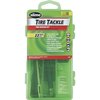I watched a video where a rider used these to repair a tire and them home.
As opposed to the gummy work type plugs these are a screw type.
They come in different sizes and have a sealant on the screw. You remove the puncture object and screw in this temporary plug. You then inflate your tire with a pump of some kind and off you limp to get the tire properly repaired or replaced.
This is just an emergency repair in my books, but looks easier than push in plugs. As for trusting them, well can you really trust any roadside plug 100%?
Here's a photo of some similar ones. Anyone ever use these?

As opposed to the gummy work type plugs these are a screw type.
They come in different sizes and have a sealant on the screw. You remove the puncture object and screw in this temporary plug. You then inflate your tire with a pump of some kind and off you limp to get the tire properly repaired or replaced.
This is just an emergency repair in my books, but looks easier than push in plugs. As for trusting them, well can you really trust any roadside plug 100%?
Here's a photo of some similar ones. Anyone ever use these?





